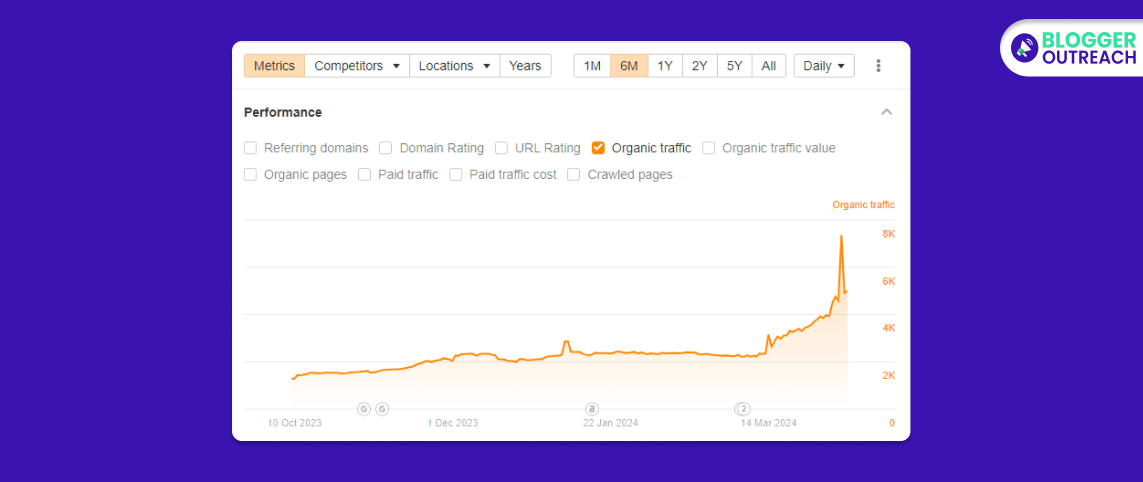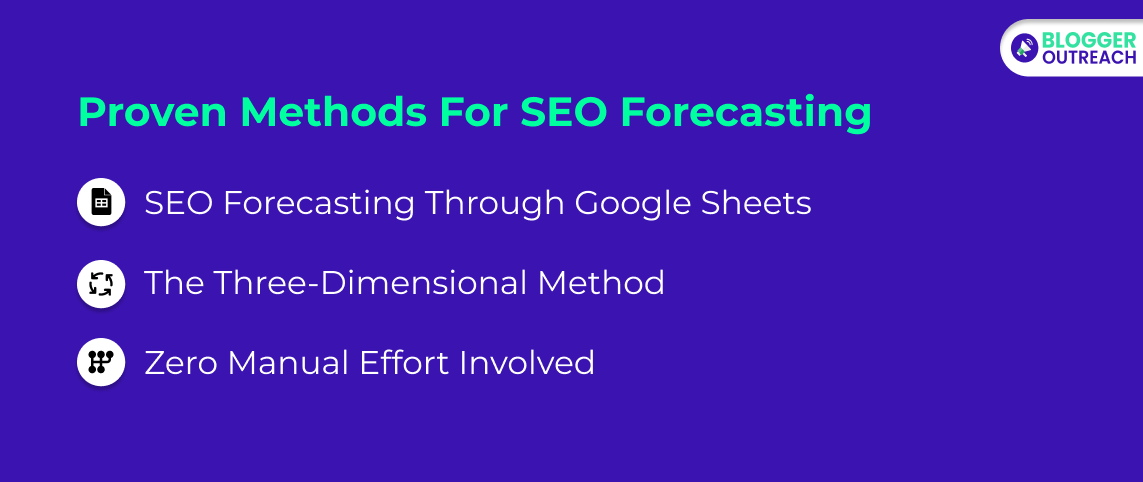Table Of Content
“Prevention is better than cure.” We all have heard this quote. Right? From an SEO perspective, the following data is a testament to this common belief:
58.4% of search enthusiasts do SEO forecasting monthly or quarterly.

And this will be going rise with time.
Today, staying ahead in digital marketing has become even more critical, particularly the way Google is updating its algorithm.
SEOs are finding it challenging to secure a competitive edge. Recognizing this, it’s crucial to be able to predict the effectiveness of your SEO strategy.
SEO forecasting, when executed correctly, is a powerful tool to estimate the return on investment (ROI) of your SEO campaigns. It enables you to predict traffic levels, search rankings, and the overall potential impact of your SEO efforts with precision.
In this article, we will explain SEO forecasting step-by-step and discuss its details.
Table Of Contents
What is SEO Forecasting?
What are the benefits of SEO forecasting?
Types of SEO Forecasting
SEO Forecasting Template – How to Do It Practically (with data)?
Three Proven Methods of SEO Forecasting:
- Through Google Sheets.
- Three-dimensional method.
- A method that requires Zero manual effort.
What Is SEO Forecasting?

SEO forecasting is predicting the outcomes of your SEO efforts through a data-driven approach. It estimates organic traffic, the value derived from the traffic, overall visibility, etc.
For example, why do you check the weather forecasts? Because you make your plans according to that, right?
Similarly, SEO forecasting empowers you to make informed decisions. You can plan ahead of time and decide what will work and what won’t. This is also crucial given that SEO is a time-consuming tactic, so wasting time on something that won’t get you results is not smart.
Another aspect of it is knowing the probable challenges beforehand. Yes, SEO forecasting empowers you to know and address the challenges before they become reality.
What Are The Benefits Of SEO Forecasting?
SEO is a time-consuming affair. So rather than wasting your time on strategies that won’t bring results…
It is better to estimate if you are working on a strategy to give you results.
(i) Predicts Your SEO Outcomes: Whether you are an individual or a business, SEO forecasting will help you estimate your traffic, potential, leads, and sales.
(ii) Embrace Algorithm Updates Effectively: Also, with SEO forecasting, you can better prepare for algorithm updates. For example, if we talk about the current scenarios, content is and will be the main driving force in SEO.
Similarly, you can forecast by analysing the current trends of the search world. The result? This will help you stay ahead of the major algorithm changes. At the same time, you will remain calm and composed when the rest of the world is grappling with updates.
(iii) Adapting To The Emerging SERP Changes: Google is constantly testing something or other. So, keeping up with the latest trends, such as SGE, voice search, forum-integrated results, etc., is inevitable. This is where forecasting plays a big role in devising a future-proof strategy.
(iv) Rought Calculate The ROI Of Your SEO Campaign: Move beyond technical aspects. Forecasting can also help you to predict financial benefits. Benefits? Plenty. Such as effective allocation of resources, prioritizing SEO tasks, and measuring the success of campaigns.
(v) Competitive Advantage: Overall, when you are well prepared, you can stay ahead of the SEO curve, which will help you outperform your competition.
Types Of SEO Forecasting
There isn’t a single, universally defined set of SEO forecasting types, but here are some common approaches with examples to illustrate how they work:
(i) Data-Backed Techniques
Data reflects reality. This is why leveraging a data-powered SEO forecasting method makes sense – it keeps the guesswork out of the picture. Well, let’s understand with real-life examples.
(ii) Keyword Tracking
Let’s say you’ve been tracking the ranking for the term “hiking boots” for the past year. You see a consistent rise in your ranking, moving from position 10 to position 5.
Based on this historical data, you can cautiously forecast a continued rise in ranking. And you predicted that if you can improve the page’s user experience, it can reach the top 3 positions in the next few months. This would likely lead to an increase in organic traffic for “hiking boots” on your website.
(iii) Analytics Analysis
Using Google Analytics, you see a consistent month-over-month increase in organic traffic from informational blog posts about different hiking trails.
Then, you can forecast that continuing to create high-quality content on this topic will likely lead to further organic traffic growth.
(iv) Competitor Research
After analyzing your competitor’s SEO strategy, you discover they rank highly for the term “best backpacking tents” with a long-form buying guide.
Now, you thought about creating something similar (or even better) – a well-optimized guide on your site has the potential to outrank them.
(v) Seasonality Analysis
Again, there are instances when you see a traffic surge for specific keywords. For example, let’s say that you run an online gardening store.
Now, after seeing the historical traffic data, you see a surge in traffic for terms like “vegetable seeds” and “fertilizer” every spring. This seasonality trend can be factored into your SEO forecast.
Another example can be the high search for terms like ‘Christmas decor ideas’, ‘Holiday recipes’, and ‘DIY Christmas gifts’ during the Christmas season.
SEO Forecasting Template – How To Do It Practically (With Data)?
Now that you understand SEO forecasting…
…Let’s go through a real-life example of it, focusing on traffic prediction for a hypothetical e-commerce website specializing in outdoor gear.
We’ll use a simplified approach based on historical data and keyword performance. You can also use this example as a template to estimate your campaign’s results. So, let’s begin.
Background
- Website: Sportzeee.com (hypothetical).
- Historical Data: Data from the past 12 months.
- The goal is to forecast the next 12 months’ traffic and evaluate the potential ROI from SEO investments in increasing organic search visibility.
Step 1: Gather Historical Data
- Current Monthly Traffic: 100,000 visits.
- Average Monthly Growth Rate Over the Past Year: 5%.
- Current Conversion Rate: 2%.
- Average Order Value (AOV): $100.
- Monthly SEO Budget: $10,000.
- Average Monthly New Backlinks: 50.
- Current Rank for Target Keyword “Hiking Boots”: Position 5.
Step 2: Calculate Future Traffic
Using the formula for future traffic:
Future Traffic=Current Trafficx(1+Average Monthly Growth Rate)12
Plugging in our values:
Future Traffic=100,000x(1+0.05)12
Step 3: Estimate Traffic From New Keywords
Suppose SEO efforts will focus on improving rank for “Hiking Boots,” which has:
- Search Volume: 30,000/month.
- Expected CTR for Position 3 (after improvement): 10% (industry benchmark).
Expected Additional Monthly Traffic=30,000×0.10=3,000
Step 4: Calculate Total Expected Traffic
We’ll add the expected additional traffic to our forecasted organic traffic.
Step 5: Forecast Revenue Increase
Then, using the formula for forecasted value:
Forecasted Value=Total Expected Traffic×Conversion RatexAOV
Step 6: Calculate ROI
Now, ROI=Forecasted Value−SEO Investment/SEO Investment
Execution
Let’s calculate steps 2, 4, 5, and 6. We’ll calculate the future traffic without the keyword, the total expected traffic with the new keyword, the forecasted value from this traffic, and the ROI considering the SEO investment over the next 12 months.
Based On The Calculations:
- Future Traffic without Keyword Improvement: Approximately 179,586 visits over the next 12 months.
- Total Expected Traffic with Keyword Improvement: Approximately 215,586 visits over the next 12 months, considering the additional traffic from improving the rank for “Hiking Boots.”
- Forecasted Revenue Increase: The forecasted value from this total expected traffic is approximately $431,171.
- ROI: The return on investment from the SEO efforts, considering a $120,000 annual SEO budget, is approximately 259%.
Interpretation
- Traffic Growth: SEO efforts, including improving the rank for a targeted keyword, are expected to contribute significantly to traffic growth over the next year.
- Revenue Increase: It highlights the potential financial benefits of targeted SEO strategies.
- ROI: An ROI of 259% justifying the budget and strategies implemented.
Leverage These Proven Methods For SEO Forecasting

Take a holistic approach. Therefore, adding more methods to your forecasting knowledge. This will help you avoid errors.
Method- 1: SEO Forecasting Through Google Sheets
With Google Sheets, numbers don’t just compile but conspire to tell tales. Here’s a breakdown of creating an SEO forecast using Excel:
First, start with data gathering.
Historical Traffic: This is the foundation. Head to your Google Analytics and extract organic traffic data for at least 12 months (ideally 2-3 years for better accuracy). Include dates and corresponding organic traffic numbers. You can download this data as a CSV file.
Keyword Research: Identify two sets of keywords:
- Existing keywords your site ranks for.
- Target keywords you want to rank for in the future.
Now, it’s time to set up the Excel Sheet.
Structure: Create two main sheets:
- Historical Data: Paste your extracted traffic data here, including dates and organic traffic for each month.
- Forecast: This is where you’ll build your forecast model.
- Cleaning Historical Data: Double-check for anomalies or bot traffic and remove them for a clearer picture.
Building the Forecast Model
There are two main approaches to forecasting:
Option#1- No-Change Forecast (Baseline)
- Use the FORECAST function in Excel. This predicts future traffic, assuming no SEO efforts or changes.
- Copy the dates and traffic data from the Historical Datasheet in the Forecast sheet.
- Use the FORECAST function to generate a forecast based on your historical data. Excel provides different forecasting methods; choose the one that best suits your data (e.g., Exponential Smoothing).
Option#2 – SEO Impact Forecast
This requires more effort but offers a more realistic prediction considering SEO initiatives.
Here’s a simplified method:
Identify Factors Impacting SEO Growth:
- Keyword difficulty (tools like Ahrefs or SEMrush can help estimate this).
- Planned SEO activities (content creation, link building, etc.).
- Industry trends and potential algorithm updates (stay updated on SEO news).
Then, based on these factors, estimate the potential improvement in rankings and traffic for your target keywords. You can use a conversion rate to assess how this translates to leads and sales (optional).
Additionally, apply these adjustments to your no-change forecast to create a more optimistic forecast reflecting your SEO efforts. Use comments or additional columns to explain these adjustments.
Tips
First, be prepared for multiple scenarios. Consider creating various forecasts based on different assumptions about SEO effectiveness.
Also, add visualizations. For better understanding, use charts to present your forecasts alongside historical data.
Finally, keep it updated. So gather new data, and refresh your forecasts for better accuracy.
Method 2: The Three-Dimensional Method
Using this technique, you will use Ahrefs, Search Console, and Google Analytics to estimate your traffic.
Similarly, like the above method, you can use a spreadsheet to add your data in a place.
How?
Firstly, note the estimated monthly volume for your targeted phrases using Ahrefs. Next, head to Google Analytics to see the ACTUAL traffic you are driving from these phrases.
There are two possibilities. Either it is underperforming or overperforming.
So, evaluate the ACTUAL monthly volume you are getting out of the estimated data by Ahref. This will let you understand the expected results.
Once you finish your analysis, create a formula based on that. Apply the same to your targeted keywords for the next year.
That makes sense, right?
Well, the best thing about this method is that there is no room for guesswork.
Method 3: Zero Manual Effort Involved
Yes, if you want to keep the manual effort away from your SEO forecasting, there is a way. The trick is none other than a leveraging tool called SEOmonitor.
Here is the strategy that will take you hardly 10- 20 minutes.
Heads up: Apply the following steps once you have created your account. Okay?
So Let Us Break Down The Steps Involved:
Step#1 – Go to Add the website URL for which you want to forecast results.
Step#2 – Next, select the city, country, region, and currency.
Step#3 – If you already have a list of keywords, add them. Also, the tool comes with a feature that identifies the best keyword opportunities for you.
Step#4 – Select keyword intents with care. It will look similar to this:

Step#5 – Add some of your competitors’ websites. This step will help the tool develop a competitive view and share opportunities you haven’t tapped yet.
Step#6 – This step is all about goal setting (very important). So, set your start date & campaign duration. Also, add your specific keyword group and your competitor’s URL.
Step#7 – You are just a click away. Now, you can see instant results on CTR potential and seasonality during that time.
Bottom Line
Take action – pick at least one method from the above and work on it. Because…
Instead of working on something that doesn’t work – it is better to estimate before you start working on it.
Once you complete any of the methods, double-check it by applying another method.
This way, you will create a fail-proof SEO forecasting strategy.
Read Also:








